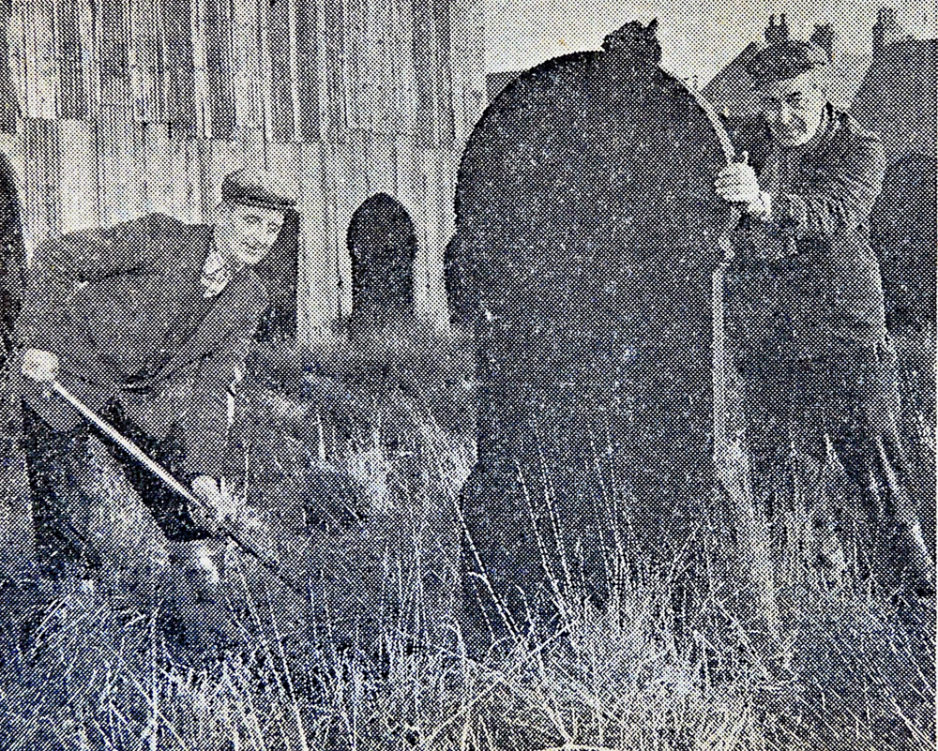Digging a Grave Part 4
So the grave is dug, be it a re-opener or a new one. Now comes the reason for its digging, that is the burial of the deceased.
The first job in the morning of the funeral is to check the state of the grave.
The grave door used by the stager that had covered the grave overnight is lifted and the grave inspected. Has it collapsed overnight? Is it full of water?
The first one is more serious obviously. No one wants the funeral hearse coming down the road and you’re still shovelling like mad. It doesn’t send out the right message of dignity and decorum.
If the grave has collapsed the extent of the problem needs to be assessed. If it is the soil heap side then that is potentially more dangerous for the entire soil heap could collapse. Probably a ton or so of wet soil moving is not good.
If it is the staging side, this may have problems for the mourners who will stand upon it during the service.
Anyway, if there is a problem and the grave cannot take the coffin, the funeral service takes place with the coffin on the staging board.
Mourners
Once the mourners have gone, this is removed to a safe place. The excavation continues until the depth is reached and the coffin can be lowered into the grave.
Anyway, let’s say the grave is intact but the water level is high. Pumping the water out is a possibility. But the pumps never were reliable. And in wet weather the water seeped back in just as quick as it was removed.
So, the usual solution was to get the water level down to a suitable level. Then, as the hearse arrived, sawdust was placed in the grave to camouflage that the coffin was to be placed into water. Just in case any of the mourners wanted to peer down the hole.
Most didn’t but you never know.
Burial
Right now to the burial.
The hearse is coming round the corner, so you nip down into the grave and remove the bottom shoring, hoist yourself out and get ready to receive the coffin.
The soil heap and the staging board would have been draped with grass sheets, the same as fruit and veg merchants use on their stalls.
The bearers will hand the coffin to the gravediggers, who hold it, one at the foot and the other at the head of the coffin. This then is laid down on to the grave or burying ropes.
On a hand dig, only 2 staff would used, on the more recent machine digs, because they are digging with effectively a digging bucket, it is too wide to stretch across for one man so 4 staff are used.
The coffin is lowered. If it is heavy, then trust me on this, it can be quite a strain as you try to lower the coffin gently.
Especially at the head end.
Let’s say that everything goes well. The box is at the bottom. You’ve draped the ropes over the soil heap to avoid a trip hazard for the mourners.
Ashes to ashes
One of you will have the job of lingering in the vicinity. Because when the phrase, ‘earth to earth, ashes to ashes, dust to dust’ is spoken you’re the guy who has to throw a handful of soil in on cue.
God forbid that a priest, minister or funeral director would get their hands dirty!
The people leave and now the work begins again.
The ropes are flipped out leaving the coffin in place and the soil is replaced. The longer shoring boards are removed and the grave is filled to its maximum.
Soil is usually heaped to a height of about 1 to 2 foot as it will settle in time.
You then place the floral tributes on the heaped soil. And on to the next one.
Some times, not often, the funeral director would say to you that the bearers will leave the flowers on the box.
This sometimes was the request of the family and the flowers were buried with the coffin. Sometimes it was because the funeral directors had brought the wrong coffin so the flowers were hiding the nameplate on the box.
This meant that when the mourners had left we did not fill the grave but simply placed the staging door over the grave until they came with the right body. It didn’t happen often as I said but an opportunity to take the piss is not to be missed.
I was hoping to have this as the last part of this series but there’s too much, so I’ll have one more to do. This will look at exhumations, the Winter of Discontent issues, the Northern Cemetery morgue and a few other things.
But the major part of this series is done, so feel free to go out and try it. I’d try it in the back garden first to get some experience. You don’t want to get it wrong do you?
‘Gravedigger’ by Pete Lowden

Pete Lowden is a member of the Friends of Hull General Cemetery committee which is committed to reclaiming the cemetery and returning it back to a community resource.

